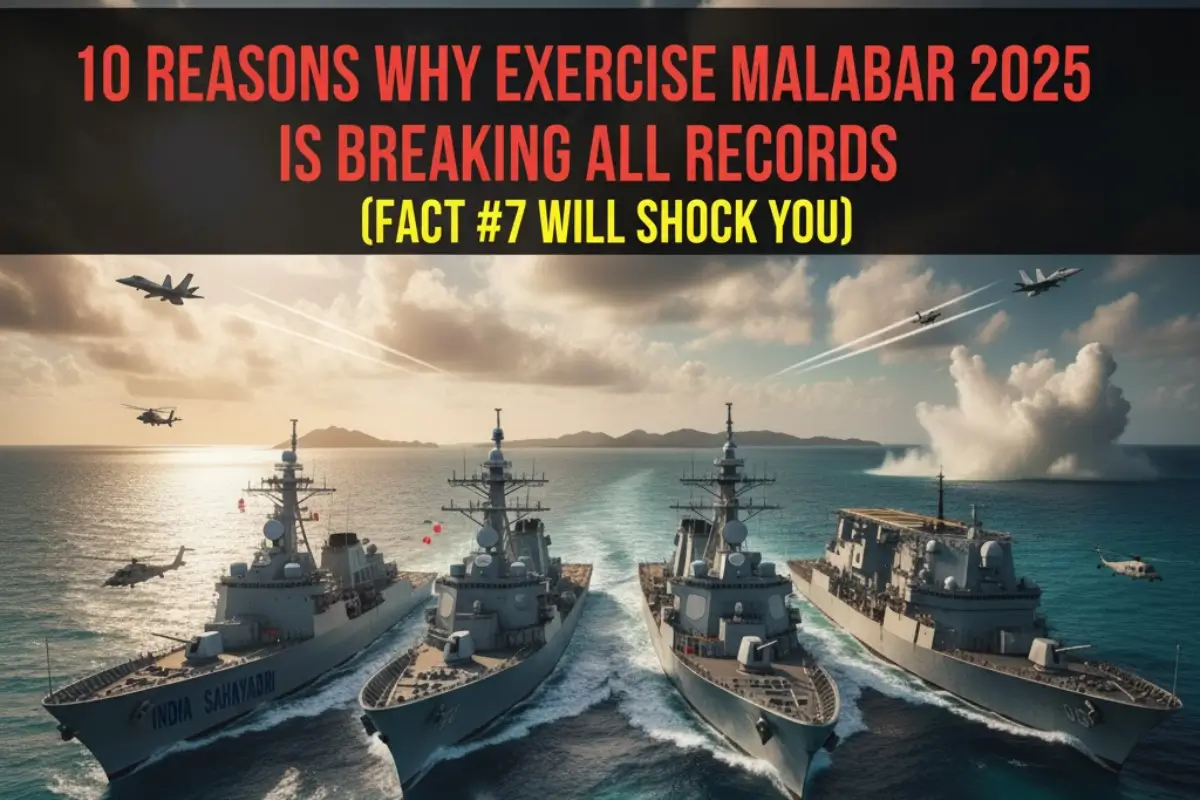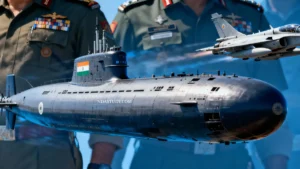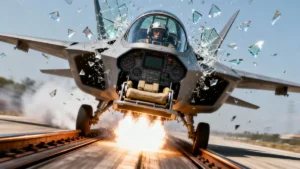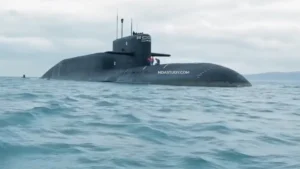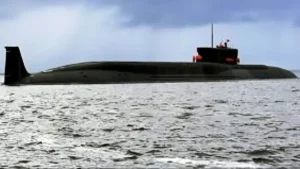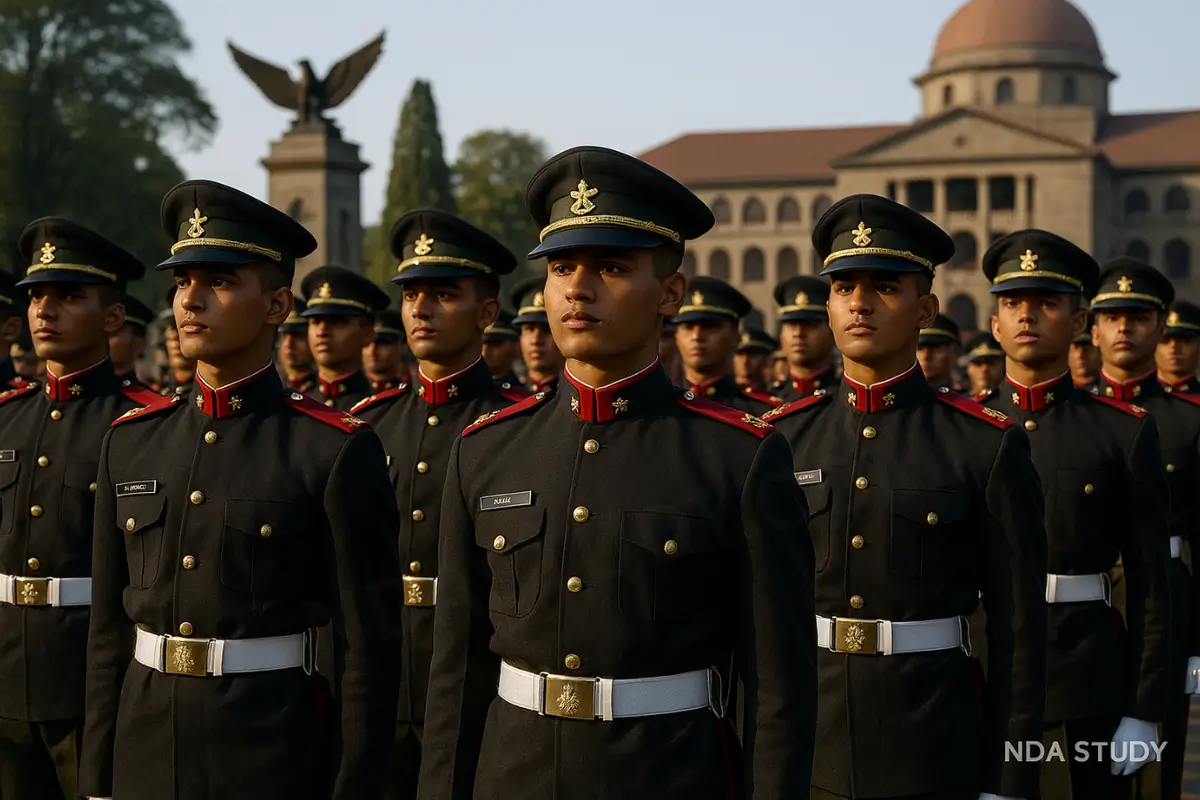Right now, as you read this, four of the world’s most powerful navies are making history in the waters off Guam. Exercise Malabar 2025, the 29th edition of the Quad’s premier naval drill, isn’t just another military exercise—it’s a game-changing demonstration of Indo-Pacific power happening from November 10-18, 2025. This multilateral exercise brings together India, the United States, Japan, and Australia for the most advanced maritime warfare training ever conducted in the Pacific theatre. From record-breaking carrier operations to live missile launches worth crores, here are 10 jaw-dropping reasons why Exercise Malabar 2025 is rewriting naval cooperation history.
1. The Incredible 33-Year Journey
When Exercise Malabar first launched in 1992 off India’s Malabar Coast, it was a simple handshake between two navies—just India and the United States with approximately four warships conducting basic coordination drills. Fast forward to 2025, and Malabar has exploded into a mini-armada featuring 17+ warships, submarines, advanced fighter aircraft, and over 2,000 naval personnel.
The evolution is staggering. What started as basic passage exercises (PASSEX) has transformed into multi-domain warfare operations covering anti-submarine warfare, air defence, surface combat, electronic warfare, and humanitarian assistance. The 1992 edition lasted just a few days with minimal equipment. Today’s Malabar 2025 spans nine days with cutting-edge technology, including P-8A Poseidon maritime patrol aircraft, MH-60R Seahawk helicopters, stealth frigates, and nuclear-powered submarines.
The numbers tell the growth story:
- 1992: 2 countries, ~4 ships, basic drills
- 2007: First expansion (5 nations briefly participated)
- 2015: Japan joined permanently, making it trilateral
- 2020: Australia returned, completing the full Quad framework
- 2025: Most sophisticated edition with unprecedented operational complexity
This 33-year journey from regional cooperation to Pacific-wide strategic partnership proves that consistent commitment builds unshakeable alliances. For NDA aspirants, this evolution mirrors your own journey—from academy cadets to commanding officers leading such historic operations.
2. The Ultimate Power Flex
In Exercise Malabar 2017, something unprecedented happened in the Bay of Bengal: three aircraft carriers operated simultaneously in a jaw-dropping display of naval might. This historic moment featured:
NS Vikramaditya (India): The 44,570-tonne modified Kiev-class carrier equipped with MiG-29K fighter jets, representing India’s blue-water naval ambitions.
USS Nimitz (United States): A 100,000-tonne nuclear-powered supercarrier—one of the largest warships ever built. Its flight deck covers 4.5 acres (bigger than three football fields!), capable of launching fighter jets every 20 seconds during combat operations. The Nimitz carried F/A-18 Super Hornets and proved why America dominates the seas.
JS Izumo (Japan): Japan’s 27,000-tonne helicopter carrier, now being modified to operate F-35B Lightning II stealth fighters, marking Japan’s return to fixed-wing carrier aviation since World War II.
Why this matters: Aircraft carriers are floating cities and mobile airbases that project power 500+ nautical miles from shore. Having three carriers coordinate operations requires extraordinary interoperability—shared communication systems, synchronised flight operations, coordinated defence zones, and mutual support protocols.
The 2020 Malabar edition also featured carrier operations when INS Vikramaditya and USS Nimitz conducted joint exercises in the Arabian Sea, marking the first full Quad naval exercise with carrier strike groups. This wasn’t just military showmanship—it was a strategic message that democratic Indo-Pacific nations can operate as a unified force.
Did You Know? A single carrier strike group represents more firepower than many countries' entire militaries. When three carriers sailed together in 2017, they commanded over 150 aircraft and 30 escort warships—a fleet larger than most navies worldwide.
3. The Nuclear Test That Almost Killed Malabar
In May 1998, India conducted Pokhran-II nuclear tests, detonating five nuclear devices and declaring itself a nuclear weapons state. The world reacted swiftly—and not positively. The United States imposed comprehensive sanctions on India, freezing military cooperation, technology transfers, and defence trade.
Exercise Malabar became collateral damage. From 1998 to 2001, the exercise was completely suspended for four years. The bilateral defence relationship that had been carefully built since 1992 seemed headed for a permanent freeze.
But here’s where the story gets inspiring: Malabar didn’t just survive; it came back stronger than ever. Several factors contributed to the comeback:
Post-9/11 strategic realignment: The September 2001 terrorist attacks shifted global security priorities. India and the US discovered shared interests in counterterrorism and regional stability. President Clinton’s historic 2000 India visit began thawing relations even before 9/11, recognising India’s democratic values and strategic importance.

2002 resumption: Exercise Malabar restarted with renewed purpose and quickly expanded in scope and complexity.From sanctions to strategic partners: By 2005, India and the US signed a comprehensive defence framework agreement. In 2016, India was designated a Major Defence Partner of the United States—one of only a handful of nations with this status.
The lesson for NDA aspirants: Strategic partnerships can survive political storms when built on shared values and mutual interests. Today's India-US defence relationship is among the strongest globally, conducting over 50 joint exercises annually across all military branches. What seemed like a death blow in 1998 actually strengthened the foundation for today's Quad cooperation.
4. Australia’s Complicated Relationship
Australia’s participation in Exercise Malabar reads like a diplomatic thriller with plot twists worthy of a Netflix series. In 2007, Australia joined Malabar for the first time during exercises in the Philippine Sea, alongside India, the US, Japan, and Singapore—creating the largest naval gathering in recent history.
Then China intervened. Beijing expressed strong displeasure, viewing the expanded exercise as a containment coalition aimed at restricting China’s maritime ambitions. Facing economic pressure (China was Australia’s largest trading partner), Canberra withdrew from Malabar after 2007 and stayed away for 13 years.
The 13-year absence (2008-2019) created an awkward situation: Australia was a founding Quad member (the Quad dialogue began in 2007), yet couldn’t participate in the Quad’s primary naval exercise. Japan joined permanently in 2015, but Australia remained on the sidelines.
What changed Australia’s mind?
China’s growing assertiveness: Belt and Road expansion, South China Sea militarisation (building artificial islands with military installations), and increased naval presence in the Indian Ocean.
Economic coercion: China imposed punitive tariffs on Australian exports (barley, wine, coal) in 2020, proving that appeasement didn’t guarantee economic security.
Regional security calculus: The strategic calculation shifted—maritime security became more important than avoiding Beijing’s displeasure.
2020: Australia’s permanent return: Following the India-China Galwan Valley clash and heightened Indo-Pacific tensions, Australia officially rejoined Malabar as a permanent member in November 2020, finally completing the full Quad naval framework.
Malabar 2025 features Australia prominently with HMAS Ballarat (Anzac-class frigate) and RAAF P-8A Poseidon maritime patrol aircraft operating from Andersen Air Force Base, Guam. The 13-year detour has ended, and Australia is now fully committed to Indo-Pacific security cooperation.
5. Malabar Went from the Indian Ocean to the Deep Pacific
Exercise Malabar’s geographic journey tells the story of expanding strategic horizons. The venue evolution mirrors the Indo-Pacific’s growing geopolitical importance:
1992-2006: Indian Ocean Focus
Early editions stayed close to India’s shores—the Arabian Sea, off India’s west coast, and the namesake Malabar Coast. These were regional exercises focused on bilateral India-US cooperation in India’s immediate neighbourhood.
2007: First Pacific Deployment
The exercise dramatically shifted to the Philippine Sea, near the contested South China Sea and Taiwan Strait. This was a deliberate signal—Malabar was going global.
2017: Bay of Bengal Spectacular
The famous three-carrier edition took place in the Bay of Bengal, India’s eastern maritime zone, where China’s “String of Pearls” strategy aims to establish port facilities.
020: Dual-Phase Innovation
For the first time, Malabar conducted two phases—Bay of Bengal and Arabian Sea—covering both India’s eastern and western maritime approaches in the same year.
2023: Australia Hosts
Malabar travelled to Sydney, Australia, marking the first time the Royal Australian Navy hosted the exercise on home waters.
2024: Return to India
The exercise came back to Visakhapatnam in the Bay of Bengal, featuring advanced anti-submarine warfare drills.
2025: Deepest Pacific Penetration
Guam represents the boldest venue choice yet. Located in the Northern Pacific, Guam is:
- Closer to Beijing than to Hawaii
- Part of the “second island chain” in the US Pacific strategy
- Home to Andersen Air Force Base and Naval Base Guam—critical forward-operating hubs
- Within the range of contested waters (South China Sea, Taiwan Strait, East China Sea)
Why location matters: Conducting Malabar at Guam sends an unmistakable message that the Quad's operational reach extends throughout the entire Indo-Pacific, not just the Indian Ocean. It demonstrates the ability to operate near potential flashpoints and shows that democratic navies can project power anywhere international law permits.
For geography students and NDA aspirants studying strategic affairs, trace Malabar's venues on a map—you'll see the expanding circle of Indo-Pacific maritime cooperation.
6. INS Sahyadri
Meet the star of Exercise Malabar 2025: INS Sahyadri (F49), a Shivalik-class guided-missile stealth frigate that has won the Indian Navy’s prestigious “Best Ship Trophy” five times—an unprecedented achievement. This indigenous warship represents India’s arrival as a serious naval power.
Technical Prowess:
- Displacement: 6,200 tonnes full load
- Length: 143 meters (about 1.5 football fields)
- Speed: 32+ knots (59 km/h)
- Crew: 35 officers + 222 sailors
Weapons & Systems:
- BrahMos supersonic cruise missiles: The world’s fastest cruise missile (Mach 2.8-3.0), giving Sahyadri strike capability against surface targets 300+ km away
- Barak-1 surface-to-air missiles: Point defence against incoming aircraft and missiles
- Advanced radar systems: 3D air surveillance, surface search, fire control
- Anti-submarine warfare: Bow-mounted sonar, torpedo tubes, RBU-6000 rocket launchers
- Helicopter capability: Can operate Sea King or Dhruv helicopters for extended reconnaissance
Stealth Features:
INS Sahyadri isn’t just powerful—it’s hard to detect. The Shivalik-class pioneered stealth design in the Indian Navy with:
- Sloped surfaces: Radar-deflecting angles reduce radar cross-section
- Enclosed mast design: Sensors hidden within composite structure
- Acoustic quieting: Reduced underwater noise signature
- Infrared suppression: Cooled exhaust reduces thermal signature
Aatmanirbhar Bharat Symbol:
Built at Mazagon Dock Limited (MDL), Mumbai, and commissioned in 2012, Sahyadri represents over 70% indigenous content. From hull design to sensor integration, this frigate proves “Make in India” produces world-class warships.
Service History:
Named after the Sahyadri mountain range (Western Ghats), the frigate has participated in multiple Malabar editions and numerous international exercises. Its five Best Ship Trophy wins demonstrate exceptional crew training, maintenance standards, and operational readiness.
At Malabar 2025, INS Sahyadri is conducting complex operations alongside American destroyers, Japanese vessels, and Australian frigates—a testament to India's naval professionalism and the ship's advanced capabilities. For every NDA aspirant dreaming of commanding such vessels, INS Sahyadri shows that indigenous Indian warships can compete with the world's best. The next generation of Shivalik-class frigates will be even more capable—and you could command them.
7. Live Missiles Worth Crores Are Actually Being Fired
Here’s the shocker most people don’t realise: Exercise Malabar isn’t just ships sailing in formation for photo opportunities. Real weapons with real warheads are being fired—and each missile costs more than most people’s houses. BrahMos Supersonic Cruise Missiles: India’s pride, each missile costs approximately ₹25-30 crore (~$3-3.5 million USD). When INS Sahyadri fires a BrahMos during Malabar, it’s a ₹25 crore message travelling at Mach 2.8 toward a target ship
Harpoon Anti-Ship Missiles: US and Australian vessels fire these radar-guided weapons, costing $1.2-1.5 million each.
SM-2 Surface-to-Air Missiles: Fired from American destroyers for air defence practice, costing $2-3 million per shot.
Torpedoes: Anti-submarine warfare drills involve live torpedo launches (with practice warheads), costing ₹8-12 crore each.
Naval Gunnery: While cheaper, thousands of rounds of 76mm and 127mm naval gun ammunition are expended, each shell costing ₹50,000-1 lakh.
Why Live Fire Matters:
Realism: Simulations cannot replicate the stress of combat—the noise, vibration, smoke, and adrenaline of actual weapons release. Live fire proves systems work under real conditions.
Validation: Crew training is tested with actual weapon handling, target tracking, and damage assessment. This identifies problems that simulations miss.
Deterrence: Adversaries watching (yes, China sends surveillance ships—see Fact #9) see actual capability, not theoretical capability. A video of a BrahMos hitting a target at Mach 3 is worth a thousand diplomatic statements.
Interoperability: Coordinating live fire between four navies requires precise communication, airspace deconfliction, and safety protocols. This builds trust and operational confidence.
Recent Malabar Live-Fire Highlights:
Malabar 2023 (Sydney): Multiple live weapon firings off the Australian coast, including surface-to-surface engagements and anti-air drills.
Malabar 2024 (Bay of Bengal): Surface warfare exercises with live gunnery serials and missile launches.
Malabar 2025 (Guam): Sea phase (November 13-17) includes complex live-fire scenarios in designated Pacific training ranges. The Bottom Line: When you see news about Exercise Malabar, understand that billions of rupees worth of weapons are being fired. This isn’t symbolic cooperation—it’s proving that Quad navies can fight together if needed. That’s the record-breaking commitment that separates Malabar from ceremonial exercises.
8. Cricket Matches and Cultural Nights
After intense anti-submarine warfare drills and missile launches, what do elite naval warriors do? Play cricket, of course! Exercise Malabar’s Harbour Phase (November 10-12, 2025) features a surprisingly human side that builds bonds beyond the battlefield.
Sporting Competitions:
Cricket Matches: The most anticipated event. India vs. Australia cricket matches during Malabar have become legendary—combining the two nations’ obsessions with the sport. American and Japanese sailors join teams, learning cricket rules on the fly.
Basketball & Volleyball: US sailors typically dominate basketball courts set up on pier side, while mixed-nation volleyball tournaments create unexpected friendships.
Tug-of-War: The classic strength contest between ship crews builds camaraderie and provides hilarious photo opportunities.
Cultural Exchange Events:
National Performances:
- Indian sailors perform classical dance or Bollywood routines
- American bands play jazz and contemporary music
- Japanese officers demonstrate traditional taiko drumming
- Australian teams showcase Aboriginal cultural presentations
Food Festivals: Each nation’s mess cooks prepare traditional cuisine. Imagine: samosas, burgers, sushi, and meat pies served side-by-side. Sailors discover that good food is a universal language.
Cross-Deck Visits: Personnel tour each other’s ships, comparing technology, living quarters, and operational procedures. An Indian sailor stepping aboard USS Dewey sees American carrier operations firsthand. Australian officers visiting INS Sahyadri learn about BrahMos missile systems. Formal Receptions: Commanding officers host evening events with speeches, toasts, and formal dining. Malabar 2024 featured a dual reception hosted aboard HMAS Stuart and JS Ariake simultaneously.
Why This Matters:
Trust Building: Personal relationships formed during the harbour phase translate to operational trust during combat operations. When you’ve played cricket with someone, you trust them more during complex naval manoeuvres.
Cultural Understanding: Breaking down national stereotypes creates mutual respect. An American sailor learning about Indian Navy traditions gains appreciation for different approaches to common goals.
Morale Boost: After weeks of preparing for Malabar and before intense sea phase drills, recreational activities relieve stress and energise crews.
Long-Term Bonds: Today’s junior officers are tomorrow’s admirals. Friendships formed during the Malabar 2025 harbour phase might influence strategic decisions in 2045.
For NDA Aspirants: Military life isn’t just combat training. Diplomatic skills, cultural sensitivity, and personal relationships are equally important. The ability to represent India professionally at international events is as crucial as tactical expertise.
Exercise Malabar proves that even in the serious business of defence, there’s room for humanity, friendship, and yes—a good cricket match.
9. China Sends Spy Ships to Watch
Here’s an open secret: Exercise Malabar always has an audience—and it’s not friendly. China’s People’s Liberation Army Navy (PLAN) routinely positions surveillance vessels near Malabar exercise areas to gather intelligence.
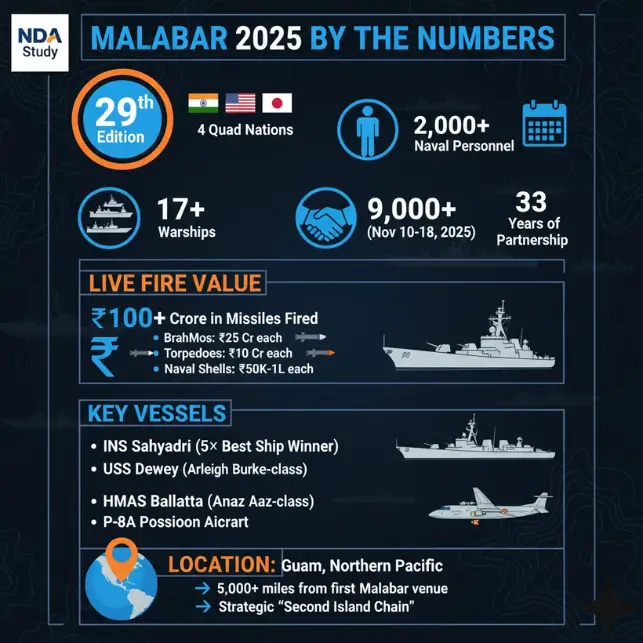
The Spy Ship Tactics:
Legal but Intrusive: Chinese intelligence-gathering ships position themselves in international waters (just outside territorial boundaries), making their presence legal under maritime law but clearly provocative.
Electronic Surveillance: These vessels are packed with:
- Signals intelligence (SIGINT) equipment: Intercepts radio communications, monitors radar emissions
- High-resolution cameras: Photographs ship movements, flight operations, tactical formations
- Acoustic sensors: Record sonar signatures for submarine identification
- Data fusion systems: Analyse collected intelligence in real-time
What China Learns:
Tactical Procedures: How Quad navies coordinate complex operations—formation patterns, communication protocols, command structures.
Technology Capabilities: Radar performance, sensor ranges, electronic warfare countermeasures, and weapons systems employment.
Interoperability Gaps: Where coordination breaks down, communication delays occur, or cultural differences cause friction.
Strategic Intentions: Frequency and location of exercises indicate the Quad’s strategic priorities and operational focus areas.
Historical Examples:
Malabar 2020: During exercises in the Arabian Sea and Bay of Bengal, Chinese Type 815 surveillance ships were reported near operating areas.
Malabar 2024: Intelligence reports indicated PLAN presence monitoring exercises off Visakhapatnam.
Malabar 2025: Given Guam’s proximity to contested waters, Chinese surveillance is virtually guaranteed—possibly including submarine shadowing in addition to surface ships.
Quad’s Response:
Counter-Surveillance: Quad navies also monitor Chinese vessels, tracking their movements and capabilities. This cat-and-mouse game provides mutual intelligence.
Operational Security: Sensitive communications use encrypted systems. Critical drills occur in restricted areas with enforced security zones.
Strategic Communication: The Quad knows China is watching—and sometimes that’s the point. Demonstrating capability serves as deterrence.
Beijing’s Official Reactions:
Public Statements: The Chinese Foreign Ministry routinely criticises Malabar as “Cold War mentality,” “bloc politics,” and “Asian NATO”—terms used to portray the Quad as an aggressive alliance.
Also Read:
DRDO tested K-5 SLBM Stage-2 Motor Successfully: India’s Nuclear Triad Sea-Leg Breakthrough
Delhi Defence Dialogue 2025: India’s New-Age Defence Technology Revolution Explained
World’s Highest Fighter Base: India’s Nyoma Airbase at 13,700 Feet Operationalised Near LAC
Diplomatic Protests: China has raised concerns with host nations, arguing that exercises destabilise the region.
Media Campaign: State-controlled media publishes articles warning against “containment coalitions” and emphasising China’s peaceful intentions.
Despite protests, China closely studies Malabar to understand Quad naval capabilities and inform its own military development. Meanwhile, the Quad maintains that exercises are defensive, focused on freedom of navigation, rules-based order, and disaster relief—not targeting any specific nation. This illustrates modern great-power competition—strategic rivalry conducted through intelligence gathering, military exercises, and diplomatic messaging rather than direct conflict. Understanding this dynamic is essential for future naval officers operating in the Indo-Pacific.
10. The Future Is Here: Space, Cyber, and AI Integration Coming to Malabar
Exercise Malabar 2025 already represents cutting-edge naval warfare, but the future promises even more revolutionary changes. The next frontier is integrating emerging technologies that will define 21st-century maritime dominance.
Space-Based Operations:
Satellite Communications: Real-time data sharing between Quad navies via secure satellite networks, enabling coordinated operations across thousands of miles.
Navigation Systems: GPS, GLONASS, and India’s NavIC (Navigation with Indian Constellation) provide precise positioning for weapons and vessels.
Reconnaissance & Surveillance: Space-based radar and optical satellites track ship movements, monitor maritime chokepoints, and identify threats before they’re visible from sea level.
Cyber Warfare Integration:
Defensive Cyber Drills: Protecting naval networks from cyberattacks—exercises simulate attempts to hack ship systems, communication networks, and weapons controls. While not publicly detailed, modern naval warfare includes electronic attack capabilities to disrupt adversary communications and sensors. Countering disinformation, maintaining maritime domain awareness through data fusion from multiple sources.
Artificial Intelligence & Unmanned Systems:
Autonomous Drones: Aerial and underwater drones for reconnaissance, mine detection, and anti-submarine warfare. Future Malabar editions will likely feature coordinated operations between manned ships and AI-controlled drones. Machine learning systems that identify threats faster than human operators, though ultimate firing decisions remain with personnel. AI analyses ship systems to predict failures before they occur, improving operational readiness.
Current Emerging Technologies in Malabar:
Maritime Domain Awareness (MDA): Real-time information sharing platforms connect Quad navies, tracking vessel movements, identifying illegal fishing, piracy, and smuggling. Advanced jamming and spoofing capabilities are already part of Malabar drills, disrupting adversary sensors and communications.
Humanitarian Assistance & Disaster Relief (HADR): Post-pandemic emphasis on coordinated disaster response using naval assets—relevant as climate change increases extreme weather events.
Hypersonic Weapons: Next-generation missiles travelling at Mach 5+ are being developed by all Quad nations. Future Malabar editions may test these systems.
Directed Energy Weapons: Laser-based missile defence systems are moving from testing to deployment on US Navy vessels.
Future Expansion Possibilities:
Additional Partners: France expressed interest in joining Malabar in 2021. South Korea could become an observer.
Formalisation Debate: Will Quad evolve from an informal partnership to a treaty-based alliance like NATO? Current consensus favours flexibility, but this could change. Future exercises might include space operations centres, cyber command facilities, and combined intelligence fusion cells.
Expert Perspectives:
US commanders have stated that Malabar’s interoperability has reached a level where forces “could operate for real” in combat scenarios—no longer just training but genuine operational integration. Australian officials emphasise the exercise addresses “evolving security challenges” requiring multi-domain responses. Indian Navy describes recent editions as the “most comprehensive Malabar to date,” with expanding complexity annually.
The Vision for 2030:
Imagine Exercise Malabar 2030: Satellite networks coordinate operations, AI drones hunt underwater threats autonomously, cyber warfare teams defend against digital attacks, hypersonic missiles streak across test ranges at Mach 6, and directed energy weapons intercept incoming threats with light-speed precision. This isn’t science fiction—it’s the logical evolution of current trends.
The Navy you’ll join is transforming rapidly. Future officers need technical expertise beyond traditional seamanship—understanding AI, cyber operations, space systems, and data analytics will be as important as navigation and gunnery. Exercise Malabar’s evolution shows where your career is headed: multi-domain operations requiring both classical military skills and cutting-edge technological knowledge.
Why Malabar 2025 Matters to You
Exercise Malabar 2025 represents far more than warships conducting drills near Guam. This 33-year-old tradition has evolved from a simple bilateral exercise into the Indo-Pacific’s most significant demonstration of democratic naval unity. For India, Malabar showcases the transformation from a coastal defence force to a blue-water navy capable of operating alongside the world’s most advanced maritime powers. INS Sahyadri, leading operations at Guam, proves “Make in India” produces world-class platforms.
For NDA aspirants, Exercise Malabar offers a window into your future. In 15 years, YOU could command INS Sahyadri or its successor. You’ll navigate the complex geopolitics of great-power competition while building partnerships with navies worldwide. Understanding exercises like Malabar isn’t just exam preparation—it’s understanding the strategic environment you’ll operate in throughout your career.
Malabar plays a crucial role in securing the maritime domain for every Indian citizen, as it protects the routes through which 90% of India’s trade travels. The warships stationed in the Pacific are safeguarding these economic lifelines and ensuring regional stability. As the sea phase comes to an end on November 17 and the overall exercise concludes on November 18, 2025, it’s important to recognise that the impact of Malabar goes beyond these nine days. The relationships formed, procedures improved, and capabilities showcased during this period will significantly influence Indo-Pacific security for years to come.
Exercise Malabar 2025 isn’t just breaking records—it’s writing the future of maritime cooperation. And that future is being written right now, in the waters off Guam, by four democracies united in purpose.
